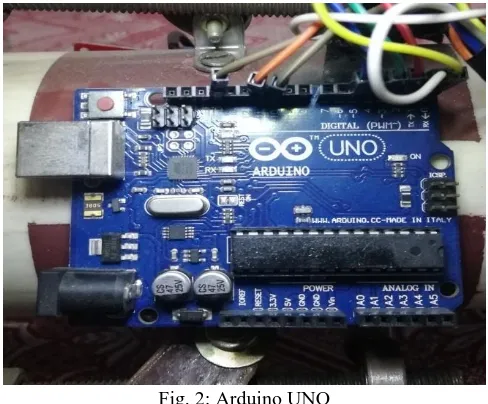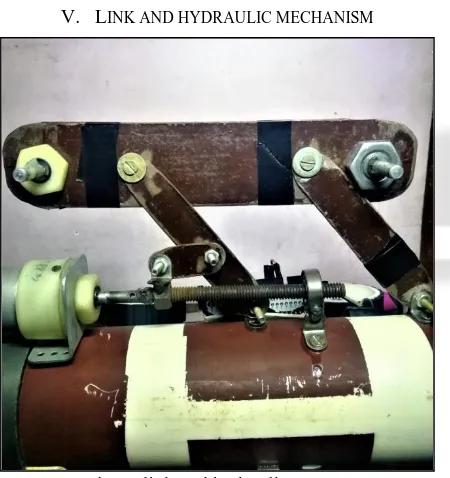Pipe Inspection Robot
Sharad Rawat
1Shivanshu Ranjan
2Shubham Tiwari
3Shubham Singh
4Mr. Rohit Jain
51,2,3,4
Student
5Assistant Professor
1,2,3,4,5Department of Mechanical Engineering
1,2,3,4,5
United College of Engineering and Management, Allahabad, Uttar Pradesh, India
Abstract— Pipelines are used to transport various contents like drinking water, crude oil, sewage, radioactive materials all around the world. Pipelines are prone to damage by corrosion, cracking and potential design flaws, they require regular visual inspection, so we make a pipe inspection robot. We created a robot used for in-pipe inspection, it is a true wireless robot. Hydraulic action, camera, lights and movement of the robot is controlled by a microcontroller system to make it a wireless robot. The mechanism used involves a hollow cylindrical base on which three frame link mechanism is attached. DC Motors are attached to the wheels to achieve the drive required. The microcontroller system comprises of an arduino UNO, Bluetooth module and a motor driver. The camera is mounted on the top of the assembly and is used for visual inspection. Through visual inspection detection of cracks, buckle, corrosion, pitting and many other flaws can be detected.
Keywords: Microcontroller, DC Motors, Arduino UNO, Bluetooth Module, Motor Driver
I. INTRODUCTION
Pipelines are used to transport and distribute gases and liquids in industries. So inspection of pipeline is an important task to ensure that there are no defects which can lead to problems such as leakage which can cause fatal hazard such as an explosion in industries. Pipe inspection robot is designed to remove human intervention from labor intensive and hazardous work environment, it is also helpful in reducing operating and safety risk, and increasing profitability. It can be used for inspecting difficult and unpiggable pipelines, sewer and storm drains, process pipes, trenchless construction and civil engineering operations, high energy pipes, boiler, furnace tubes and HVAC ducting, transmission and distribution lines. It can also be used to inspect weld integrity. These robots promote time and cost efficiencies with ensuring the safety of both human and environment. With use of pipe inspection robot nondestructive inspection of pipes can be done. It is a simple and energy efficient robot, and requires less maintenance.
II. ELECTRICAL DESIGN
The electrical circuit consists of several parts: Arduino UNO
[image:1.595.309.548.139.363.2] Motor driver Bluetooth module Power Supply
Fig. 1: Block Diagram
A. Arduino UNO:
The Arduino UNO is an open-source microcontroller board, it is based on the Microchip ATmega328P microcontroller and it is developed by arduino. The board is provided with sets of digital and analogue input/output pins, and the board is programmable with the arduino integrated development environment (Arduino IDE) via type B USB cable. Power is supplied to the board by a USB cable or by an external battery, it accepts voltages between 7 to 20 volts. The arduino UNO board is the first in a series of USB arduino boards.
Fig. 2: Arduino UNO
B. Motor Driver:
[image:1.595.306.550.481.683.2]another screw terminal block for the ground pin, the VCC for motor and a 5V pin which can either be an input or output.
Fig. 3: L298N Motor driver
C. Bluetooth Module:
HC-06 Bluetooth module is used for short range wireless data communication between systems. The module works on Bluetooth 2.0 communication protocol and it acts as slave device. For wireless data transmission it is the cheapest method and is more flexible compared to other methods. Its transmission speed is up to 2.1 mbps. This module works on the frequency range from 2.402 GHz to 2.480 GHz. HC-06 module has six pins and we have only used four pins for successful interfacing the module. The communication with HC-06 module is done through UART interface. This interface helps the module to receive and send data.
Fig. 4: HC-06 Bluetooth module
D. Power Supply:
[image:2.595.52.278.87.277.2]We have used a 12volt 1.2AH sealed lead acid battery, it is a rechargeable battery and has a capacity of 12mAh. Sealed lead acid batteries are maintenance free, easy to handle, rugged and economical. It has a characteristic of high discharge rate, wide operating temperature, long service life and deep discharge recovers. Spill proof construction of this product allows safe operation in any position and the power/volume ratio yields unrivaled energy density.
Fig. 4: Battery
III. DC MOTORS
A DC motor is a rotary electrical machine that converts direct current electrical energy into mechanical energy. Nearly all types of DC Motors follow some internal mechanism, it could be electromechanical or electronic. These mechanisms are used to periodically change the direction of current flow in part of the motor. We have used a total of 9 DC motors, they are separated in two parts to perform two different movements in the robot. First part consists of 6 DC motors which are used for the movement of the wheel. Second part consists of 3 DC motors which are used for hydraulic movement in the robot. These Motors are driven by L298N motor driver. The speed of the motor is 30 RPM.
Fig. 5: DC motors
IV. MICROCONTROLLER PROGRAMMING
[image:2.595.49.287.431.634.2] [image:2.595.309.546.461.650.2]Fig. 6: Arduino IDE software
V. LINK AND HYDRAULIC MECHANISM
Fig. 7: link and hydraulic system
We have utilized the hydraulic mechanism in order to make this project work. This consists of a DC motor attached to a lead screw which on regulation helps in the contraction and expansion of the link. Through this mechanism our robot can adapt various pipe diameters. This mechanism is based on the motion of screw.
Link follows simple parallelogram mechanism, this mechanism is designed in such a way as to expand and contract between the chosen limits. Simple parallelogram linkage offers uniform motion. Links are the major part of the robot which translates motion, links are connected to form a linkage. The motor and wheels are mounted on the links.
VI. VISUAL INSPECTION & CONTROL SYSTEM
[image:3.595.307.549.117.308.2]Visual inspection inside the pipe is done by surveillance remote camera. It is a wireless camera and can record live video with night vision support.
Fig. 8: Camera & Lights
LED lights are also used for inspection and are powered by 12V battery.
The movement, camera and hydraulic control of the robot is fully wireless. The Robot is controlled through a mobile app with the help of bluetooth connection. The connection between the robot and the mobile is established with the help of HC-06 bluetooth module. And an android application works as a user interface to command the robot. The bluetooth module receives the signal from the mobile and transfer it to arduino UNO module and then arduino module transfer it further to motor driver module then the motor driver drives the motors as per the given command.
[image:3.595.58.283.322.561.2] [image:3.595.318.538.448.750.2]VII. CONCLUSION
By doing this project we conclude that, we can reduce human intervention from labor intensive and hazardous work environment. These robots can take place of human in dangerous work areas. Inspection of pipeline is very dangerous for human in industries like nuclear power plant, conventional power plant, refineries, chemical and petrochemical plan. So, we should use pipe inspection robot for doing this work.
We have designed a pipe inspection robot which can move forward and backward and can turn according to the bend in the pipe, it is a wireless controlled robot. It can adapt various pipe diameters because of its hydraulic mechanism. And has a wireless night vision camera to detect any crack, leakage, deposit or any other flaws or abnormality in the pipe. It reduces operating and safety risk and increases profitability and efficiency.
[image:4.595.284.548.64.544.2]Future improvement can be done in the pipe inspection robot by adding various sensors for better inspection of pipes and we can also add location sensor to determine the robot latitude and longitude to know the exact location of the robot inside the pipe.
Fig. 10: Front view of Pipe Inspection Robot
Fig. 11: Side view of Pipe Inspection Robot
Fig. 12: Pipe Inspection Robot in pipe
REFERENCES
[1] Dr. Suwarna Torgal, Non Destructive Inspection of Pipe using Pipe Inspection Robot. IOSR Journal of Mechanical and Civil Engineering, Volume 13, Issue 3, Ver. I (May- Jun. 2016), PP 87-89.
[2] Hanaa Said Salim Al-Hajry & G.R. Ramesh kumar, Design and Testing of Pipeline Inspection Robot. International Journal of Engineering Innovation & Research, Volume 2, Issue 4
[3] Dr. Sharanabasappa C. Sajjan, Naveen Srivatsa H.S, Dinesh Kumar P, DESIGN AND DEVELOPMENT OF PIPE INSPECTION ROBOT. ISSN (PRINT): 2393-8374, (ONLINE): 2394-0697, VOLUME-2, ISSUE-12, 2015
[image:4.595.48.287.326.544.2]


